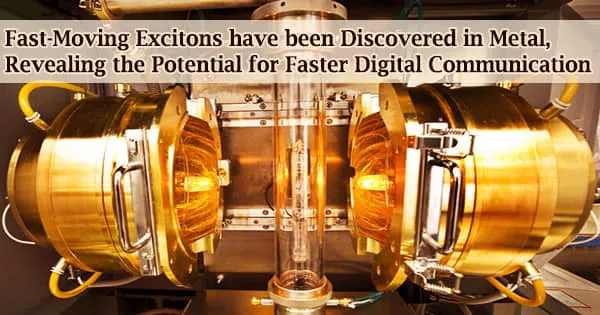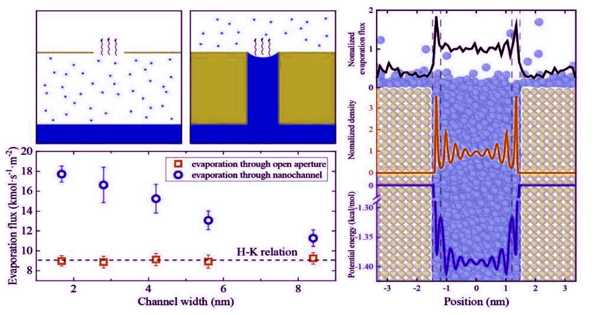Excitons energized electrons coupled to empty electron “holes” can live persistently and travel fast through metal, according to a research lead by a physicist at City University of Hong Kong (CityU).
Excitons can be created by light energy and have no electrical charge, making them viable candidates for a faster alternative to free electrons as a transport of digital information. Excitons are created when certain materials absorb light energy to excite electrons, which are negatively charged particles in atoms.
The electrons are boosted to a higher energy level, allowing positively charged spaces or “holes” to remain in their original positions. A hole and an excited electron can pair up without recombining due to electrostatic attraction, generating an exciton that behaves like an uncharged particle.
“When an exciton’s electron recombines with a hole, energy is emitted as light, which could be harnessed for data transfer in the optoelectronics industry,” says team co-leader Dr. Ma Junzhang, Assistant Professor in the CityU Department of Physics.
“Excitons would be better data carriers than free electrons, whose negative charge slows them down, but excitons are very unstable, especially in metals. In fact, before our study, stable and mobile excitons were thought to be impossible in metals.”
Because of a combination of ideal test conditions and unique properties of their selected material, tantalum triselenide, TaSe3, the researchers were able to generate and identify excitons in metal. The findings were published in Nature Materials in an article titled “Multiple mobile excitons expressed as sidebands in quasi-one-dimensional metallic TaSe3,” which was led by CityU and the Paul Scherrer Institute (PSI) in Switzerland.
Dr. Ma Junzhang, Professor Shi Ming, and Dr. Markus Müller from PSI were the paper’s joint corresponding authors. Researchers from Rutgers University, Princeton University, Stanford University, and other universities were among the collaborators.
Excitons are potentially more robust and efficient information carriers than free conducting electrons, which transmit our information today. Even though excitons have been found in semiconductors and have been used to design field-effect transistors, phototransistors, light-emitting diodes, and solar cells in the laboratory, almost all experimentally observed excitons move very slowly, greatly limiting their efficiency in information transfer.
Dr. Ma Junzhang
Importance of excitons as robust information carriers
Because of its charge neutrality and ability to flow through solids, the exciton is projected to play a significant role in the future of information transmission. Excitons, unlike negatively charged free electrons, are unaffected by external electric forces, magnetic fields, or material imperfections.
“Excitons are potentially more robust and efficient information carriers than free conducting electrons, which transmit our information today,” says Dr. Ma. “Even though excitons have been found in semiconductors and have been used to design field-effect transistors, phototransistors, light-emitting diodes, and solar cells in the laboratory, almost all experimentally observed excitons move very slowly, greatly limiting their efficiency in information transfer.”
Most crucially, in metals, excitons have remained elusive. Because of the abundance of free conducting electrons in metals, they are rarely reported. These free electrons, which prevents excitons from forming dampen the attraction between any one hole and electron (known as screening).
Any excitons that can occur in metals are too unstable to be used in practice or even observed experimentally. Traditional optical techniques for detecting excitons have significant technological restrictions as well.
The CityU and PSI team has made a breakthrough in the study of excitons in metals by employing a powerful and sensitive technique called angle-resolved photoemission spectroscopy (or ARPES) to analyze the electronic band structure in a crystalline solid with unusual features (TaSe3). They uncovered the existence of strong excitons traveling at high speeds through a metal, to be precise.
Experimental design
To increase the chances of exciton generation in metals, the study team went to the metallic compound TaSe3, which has a low density of free conducting electrons and thus a weak screening effect. TaSe3 is also made up of stacked layers of parallel triangular chains of selenium prisms that encase tantalum metal atoms.
Because the one-dimensional chains resemble high-speed railway tracks, it functions like a one-dimensional metal, allowing excitons to flow along a precise straight path.
The researchers hypothesized that TaSe3’s quasi-one-dimensionality would increase the attraction between electrons and holes within excitons while allowing the two charged components to be in distinct layers and chains.
The holes and electrons would be segregated from one another and prevented from mixing, preventing excitons from annihilation and extending their lifetime. The researchers used ARPES to record the electrical structure of TaSe3 in a systematic way.
The gadget used a narrow beam of high-energy light to excite electrons in the sample, causing them to escape into a vacuum while activating excitons in the TaSe3. The ARPES technology analyzed the angles and energies of the escaping electrons to reveal information about excitons’ presence, structure, and mobility.
New theoretical model of mobile excitons
After ruling out other possible explanations, the researchers determined that the presence of many stable subtypes of mobile excitons travelling at high velocity along one dimension might explain all of the observed events in their ARPES tests.
Dr. Müller then constructed a detailed theoretical model of mobile excitons in one-dimensional metals in collaboration with PSI theoretical physicist Professor Christopher Mudry. The results of the experiments were in good accord with the theoretical model.
An explanation for the many subtypes of excitons discovered is a key aspect of the paradigm. According to the researchers, excitons in TaSe3 have at least three different internal configurations that are dependent on two variables.
The first factor is whether a hole connects to one or two electrons (creating an exciton) (forming a trion).
The second factor is whether the holes and electrons are from the same TaSe3 chain and travel along it (resulting in intrachain excitons) or from neighboring chains (resulting in interchain excitons and interchain trions).
The findings are remarkable since stable excitons were previously thought to be impossible to find in metals. The research also showed for the first time that excitons may move quickly through a metal in a specified direction, which would improve data transfer efficiency in practice.
Furthermore, the team has demonstrated that surface modification (electron doping) with potassium vapour can regulate and control specific exciton behaviors in TaSe3.
The discoveries, as well as the new theoretical model, not only give a path for future research on excitons, particularly in metals, but also encourage their use as high-speed information carriers in conductivity devices.
“Our work now paves the way to generating high-velocity but tunable mobile excitons in metals,” says Dr. Ma. “This new field and direction will advance research and development in computing and communication devices that transmit optoelectronic information.”
CityU, the Chinese National Natural Science Foundation, the Swiss National Science Foundation, and the Sino-Swiss Science and Technology Cooperation all contributed to this research.
















